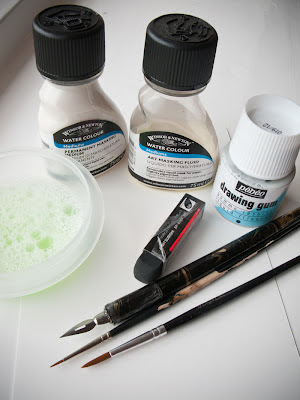Last week, I and a friend, a wonderful botanical artist, had a
chat.
She was working on an illustration of lovely streaked red-yellow apples
with light brown spots spread over the fruits. When I saw her specimen, I
immediately thought of using masking fluid for the light brown spots,
but
she said she was afraid of using it since masking fluid tends to ruin
her works. A few years ago, I will say the same. Using masking fluid
is an easy way to leave detailed or intricate white spaces but it can
also ruin my hard work when applied inappropriately.
How to avoid masking fluid from ruining your work?
 1. Masking fluid is not suitable for regular paper, such as cartridge paper, regular sketchbook, Padalarang
paper, etc. These papers would be peeled off when I removed
the masking. Test the masking fluid on the watercolour paper before
applying to a real painting. I found that I need to be more careful with
cold-pressed paper than hot-pressed one when rubbing masking fluid.
1. Masking fluid is not suitable for regular paper, such as cartridge paper, regular sketchbook, Padalarang
paper, etc. These papers would be peeled off when I removed
the masking. Test the masking fluid on the watercolour paper before
applying to a real painting. I found that I need to be more careful with
cold-pressed paper than hot-pressed one when rubbing masking fluid.
2. Masking fluid must be applied
to a perfectly dry paper and removed only when a painting is completely dry. The wrong choice of time in applying/removing masking fluid is the main reason of ruining a work.
3. Never use a fine brush! I use my inexpensive synthetic brush (actually I got it free from buying a watercolour pencil set) or a dip/ ruling pen.
4. Dip the brush into liquid dish soapy water,
rinse slightly and then wipe it before and after using the masking
fluid. I used to ruin my brushes with masking fluid but since I treat the brush regularly and repeat the soap step before applying more masking, I never clog my brushes anymore.
5.
Make sure the masking fluid is completely dry before putting a paint or
glazing the
paper. Be careful with thick masking fluid, it may look dry on the
outside
but wet inside, the brush's pressure can scrape the paper and spread the
fluid out. Masking fluid will be more transparent once it's dried.
6. From a completely dry painting/paper, gently remove masking fluid by rubbing it off with dry and clean fingers or rubber eraser. Be careful with a greasy finger, it can smear paint onto the newly uncovered area.
7. Pat down the painting to make sure all the masking fluid removed. I check any missed spots by running my fingers lightly across the paper surface.
7. Pat down the painting to make sure all the masking fluid removed. I check any missed spots by running my fingers lightly across the paper surface.
Masking
fluid made my painting process on this Cherry blossom much easier.
The masking retained the tiny white area of the stamens and carpels of
the flowers while I was painting the other area freely, putting darker
shadow or making patterns and veins. For this painting, I used Winsor
& Newton masking fluid. You can read on another post about the brand of
masking fluid I use HERE.
I used Fabriano Artistico hot-pressed paper and let the masking stay for about a week without any trouble removing it.



6 comments:
One more unique creation!Congratulations!AriadnefromGreece!
Stunning - absolutely stunning. Thanks for sharing this post.
I love masking fluid but used to not use it because I saw it as cheating. I felt that because the great artists in the 18th century didn't use it, I myself shouldn't. I have since got over this notion and use it all the time! Although I too have discovered that you really have to be careful with the paper type :S
Fabulous painting.
Again, thank you for reading and leaving a comment, Ariadne :)
Jessica, Thanks! Yes, I totally agree with the paper type. Better to know it well and test it first. Cheers :)
You can add a mask to a layer and use the mask to hide portions of the layer and reveal the layers below. Maksing layers is a valuable compositing technique for combining multiple photos into a single image or for removing a person or object from a photo.
Very helpful, thank you so much. I have made all the mistakes you mention! Now I shall return to using masking with confidence. Such a useful technique.
“Nice Post. It’s really a very good article. I noticed all your important points. Thanks"
art sets for adults
Post a Comment